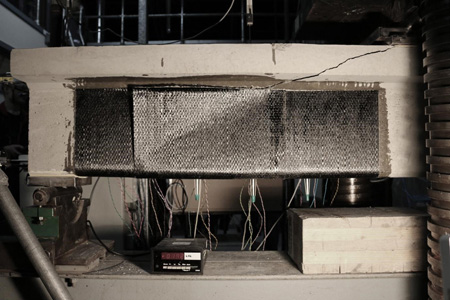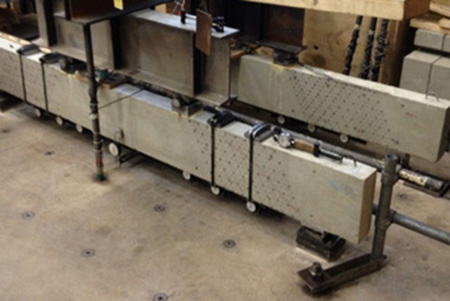Shear Strengthening using Carbon Fibre Reinforced Polymer (CFRP)

Deficiencies in the strength of reinforced concrete infrastructure can arise due to a variety of factors including deterioration, construction defects, accidental damage, changes in understanding and failure to design for future loading.
Structures that may be weak in shear are a particular concern for designers and assessors because catastrophic failures can occur with little warning. The demolition and replacement of such structures can involve large capital expenditure; environmental impacts; lengthy interruptions to service; over-burdening of nearby infrastructure; and local opposition to construction works. Approaches to strengthening existing concrete structures insitu through retrofit are therefore of considerable interest to infrastructure owners seeking to extend the lifetime of an existing structure.
The principal aim of this research is to obtain a better understanding of the strength and behaviour of reinforced concrete structures strengthened using carbon reinforced fibre polymer (CFRP) reinforcement. Externally bonded CFRP fabric systems, and the use unbonded prestressed CFRP straps are of interest. Ongoing experiments and theoretical modelling are helping to improve the understanding of aspects such as size effects and the time-dependent shear behaviour. This understanding will allow us to propose improvements to existing guidance for designers and assessors.

Collaborators
Research in CFRP bonded fabric strengthening has been previously funded by the EPSRC through grant EP/I018921/1, Lifetime extension of Reinforced Concrete Slab-on-beam Structures and undertaken in collaboration with the University of Bath and with support from ARUP, Tony Gee & Ptnrs, Highways England, Concrete Repairs Ltd, LG Mouchel, Parsons Brinkerhoff and the Concrete Society. The use of prestressed CFRP straps to strengthen reinforced concrete has been the subject of a longstanding collaboration with Professor U. Meier from EMPA and Dr A. Winistoerfer from Carbolink.
Selected References
| Jin, F. and Lees, J.M. (2019) "Experimental Behaviour of CFRP Strap Strengthened RC Beams Subjected to Sustained Loads". ASCE Journal of Composites for Construction (accepted version) (doi) |
| Foster, R.M., Brindley, M., Lees, J.M., Ibell, T.J., Morley C.T., Darby, A.P. and Evernden, M.C. (2017) "Experimental investigation of reinforced concrete T-beams strengthened in shear with externally bonded CFRP sheets " ASCE Journal of Composites for Construction 21(2) 10.1061/(ASCE)CC.1943-5614.0000743 (accepted version) (doi) |
| Foster, R.M., Haria, S., Morley, C.T. and Lees, J.M. (2017) "Shear capacity of reinforced concrete subjected to tension: Experimental results and analysis " J. Struct. Eng., 143 (9),04017085, (accepted version) (doi) |
| Foster, R.M., Morley, C.T. and Lees, J.M. (2016) "Modified Push-off Testing of an Inclined Shear Plane in Reinforced Concrete Strengthened with CFRP Fabric" ASCE Journal of Composites for Construction, 20(3) (postprint), (doi) |
| Michels, J., Barros, J., Costa, I., Sena-Cruz, J., Czaderski, C., Giacomin, G., Kotynia, R., Lees, J., Pellegrino, C. and Zile, E. (2016) Prestressed FRP Systems. In: Pellegrino C., Sena-Cruz J. (eds) Design Procedures for the Use of Composites in Strengthening of Reinforced Concrete Structures. RILEM State-of-the-Art Reports, vol 19. Springer, Dordrecht |

